
Salmon Portland Chase was an American politician and jurist who served as the sixth chief justice of the United States. He also served as the 23rd governor of Ohio, represented Ohio in the United States Senate, and served as the 25th United States Secretary of the Treasury. Chase is therefore one of the few American politicians who have served in all three branches of the federal government, in addition to serving in the highest state-level office.

The Connecticut Western Reserve was a portion of land claimed by the Colony of Connecticut and later by the state of Connecticut in what is now mostly the northeastern region of Ohio. The Reserve had been granted to the Colony under the terms of its charter by King Charles II.
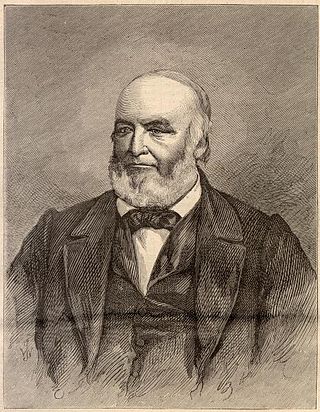
John Brough was a War Democrat politician from Ohio. He served as the 26th governor of Ohio during the final years of the American Civil War, dying in office of gangrene shortly after the war concluded.
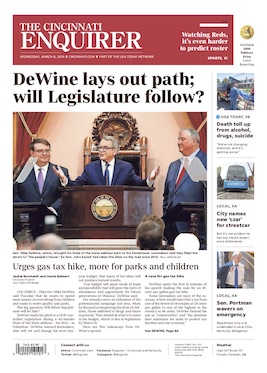
The Cincinnati Enquirer is a morning daily newspaper published by Gannett in Cincinnati, Ohio, United States. First published in 1841, the Enquirer is the last remaining daily newspaper in Greater Cincinnati and Northern Kentucky, although the daily Journal-News competes with the Enquirer in the northern suburbs. The Enquirer has the highest circulation of any print publication in the Cincinnati metropolitan area. A daily local edition for Northern Kentucky is published as The Kentucky Enquirer.
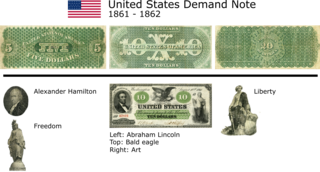
A Demand Note is a type of United States paper money that was issued from August 1861 to April 1862 during the American Civil War in denominations of 5, 10, and 20 US$. Demand Notes were the first issue of paper money by the United States that achieved wide circulation and they are still in circulation today, though they are now extremely rare. The U.S. government placed the Demand Notes into circulation by using them to pay expenses incurred during the Civil War including the salaries of its workers and military personnel.

Frank Duveneck was an American figure and portrait painter.

Robert Cumming Schenck was a Union Army general in the American Civil War, and American diplomatic representative to Brazil and the United Kingdom. He was at both battles of Bull Run and took part in Jackson's Valley Campaign of 1862, and the Battle of Cross Keys. He served two separate multi-term stints in the U.S. House of Representatives.

Spring Grove Cemetery and Arboretum is a nonprofit rural cemetery and arboretum located at 4521 Spring Grove Avenue, Cincinnati, Ohio. It is the third largest cemetery in the United States, after the Calverton National Cemetery and Abraham Lincoln National Cemetery and is recognized as a US National Historic Landmark.

During the American Civil War, the State of Ohio played a key role in providing troops, military officers, and supplies to the Union army. Due to its central location in the Northern United States and burgeoning population, Ohio was both politically and logistically important to the war effort. Despite the state's boasting a number of very powerful Republican politicians, it was divided politically. Portions of Southern Ohio followed the Peace Democrats and openly opposed President Abraham Lincoln's policies. Ohio played an important part in the Underground Railroad prior to the war, and remained a haven for escaped and runaway slaves during the war years.

Robert Seldon Duncanson was a 19th-century American landscapist of European and African ancestry. Inspired by famous American landscape artists like Thomas Cole, Duncanson created renowned landscape paintings and is considered a second generation Hudson River School artist. Duncanson spent the majority of his career in Cincinnati, Ohio and helped develop the Ohio River Valley landscape tradition. As a free black man in antebellum America, Duncanson engaged the abolitionist community in America and England to support and promote his work. Duncanson is considered the first African-American artist to be internationally known. He operated in the cultural circles of Cincinnati, Detroit, Montreal, and London. The primary art historical debate centered on Duncanson concerns the role that contemporary racial issues played in his work. Some art historians, like Joseph D. Ketner, believe that Duncanson used racial metaphors in his artwork, while others, like Margaret Rose Vendryes, discourage viewers from approaching his art with a racialized perspective.
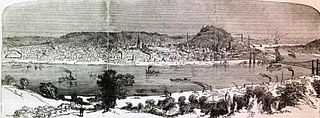
During the American Civil War, the Ohio River port city of Cincinnati, Ohio, played a key role as a major source of supplies and troops for the Union Army. It also served as the headquarters for much of the war for the Department of the Ohio, which was charged with the defense of the region, as well as directing the army's offensives into Kentucky and Tennessee.
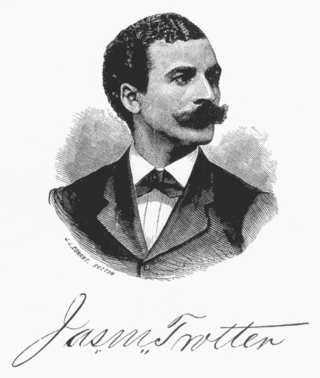
James Monroe Trotter was an American teacher, soldier, employee of the United States Post Office Department, a music historian, and Recorder of Deeds in Washington, D.C. Born into slavery in Mississippi, he, his two sisters and their mother Letitia were freed by their master, the child's father, and helped to move to Cincinnati, Ohio. He grew up in freedom, attending school and becoming a teacher.

Mound Cemetery in Marietta, Ohio, is a historic cemetery developed around the base of a prehistoric Adena burial mound known as the Great Mound or Conus. The city founders preserved the Great Mound from destruction by establishing the city cemetery around it in 1801.

Benjamin Tupper was an American soldier in the French and Indian War, and an officer of the Continental Army during the American Revolutionary War, achieving the rank of brevet brigadier general. Subsequently, he served as a Massachusetts legislator, and he assisted Gen. William Shepard in stopping Shays' Rebellion. Benjamin Tupper was a co-founder of the Ohio Company of Associates, and was a pioneer to the Ohio Country, involved in establishing Marietta, Ohio as the first permanent settlement in the Northwest Territory.
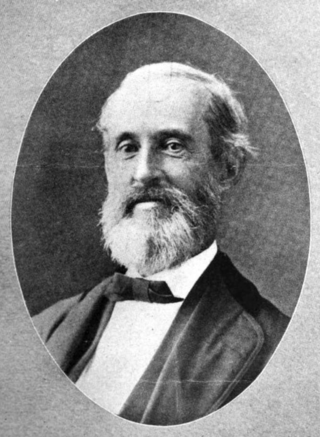
Joshua Hall Bates was a lawyer, politician, and Ohio militia general in service to the Union during the early part of the American Civil War. He was a leading recruiter and organizer of many of the first regiments of Ohio troops who volunteered after President Abraham Lincoln's call to arms in the spring of 1861.

Ephraim Cutler Dawes was a major in the 53rd Ohio Infantry and brevet lieutenant-colonel, United States Volunteers, during the American Civil War. Dawes was present at the Battle of Shiloh and Battle of Vicksburg, among others, serving under Ulysses S. Grant and William T. Sherman. One of his notable acts occurred during battle, where Dawes disobeyed and cursed an officer who had become scared and disoriented. While serving with Sherman during his march to Atlanta Dawes was seriously wounded in his lower jaw in what would be his last battle, subsequently being honorably discharged in 1864.
The following is a timeline of the history of the city of Cincinnati, Ohio, USA.

Eliza Archard Conner was an American writer, journalist, novelist, lecturer, teacher, and feminist of the long nineteenth century. Hailing from Ohio, Conner began writing for newspapers at the age of 13. She served in various roles for the Saturday Evening Post, of Philadelphia, the Commercial of Cincinnati, and the New York World of New York City. She also worked towards the emancipation and advancement of women.

The Clydesdale Motor Truck Company was a motor company that existed from 1917 to 1939 with headquarters in Clyde, Ohio. Initially, they made military trucks for World War I. Military contracts continued to be a large part of their business after the war, but they also sold into many other markets: general haulage, farming, and specialized vehicles such as fire trucks. They survived the Wall Street Crash of 1929 and the Great Depression, but increasingly struggling, they were wound up in 1939.
William Hooper was a Cincinnati businessman and politician. He was appointed state treasurer of Ohio following the resignation on September 25, 1865 of G. V. Dorsey, serving until January 1866 when S. S. Warner was sworn in.


















